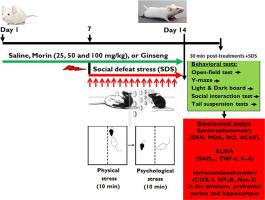Brain Research ( IF 2.9 ) Pub Date : 2020-05-28 , DOI: 10.1016/j.brainres.2020.146917 Benneth Ben-Azu 1 , Osagie Emokpae 2 , Abayomi Mayowa Ajayi 2 , Thiophilus Aghogho Jarikre 3 , Valiant Orhode 2 , Adegbuyi Oladele Aderibigbe 2 , Solomon Umukoro 2 , Ezekiel O Iwalewa 4

|
Psychosocial stress and biological predispositions are linked to mood and personality disorders related to psychiatric behaviors. Targeting neuroinflammation and oxidative stress has been recognized as a potential strategy for the prevention of psychosocial stress-induced psychiatric disorders. Morin, a bioactive compound isolated from mulberry leaf has been shown to produce antiamnesic, antipsychotic and anti-inflammatory effects relative to ginseng, a well-known adaptogen. Hence, the present study investigated the effect of morin on social-defeat stress (SDS)-induced behavioral, neurochemical, neuroimmune and neurooxidative changes in mice using intruder-resident paradigm. The intruder male mice were distributed into 6 groups (n = 10). Groups 1 (normal-control) and 2 (SDS-control) received normal saline, groups 3–5 had morin (25–100 mg/kg) while group 6 received ginseng (50 mg/kg) intraperitoneally daily for 14 days. Thirty minutes after treatment from days 7–14 onwards, mice in groups 2–6 were exposed to SDS for 10 min physical and psychological confrontations respectively with aggressive-resident mice. Neurobehavioral effects (locomotor activity, cognitive performance, anxiety- and depressive-like behavior) were assessed on day 14. Biomarkers of oxidative/nitrergic stress and neuroinflammation; acetylcholinesterase (AChE) and glutamic-acid decarboxylase-67 (GAD67) were measured in the striatum, prefrontal-cortex and hippocampus. Behavioral deficits induced by SDS were attenuated by morin and ginseng. Both morin and ginseng decreased malondialdehyde, nitrite levels and increased glutathione concentrations in the brain regions. They also reduced inflammatory mediators (TNF-α, IL-6, COX-2 and NF-κB), AChE activity and Nox-2 expression in the specific brain regions. However, morin increased the levels of GAD67 in the striatum, prefrontal-cortex and hippocampus in contrast to ginseng. Our results suggest that morin mitigates SDS-induced neurobehavioral deficits through enhancement of GAD67, inhibition of AChE activity, oxidative stress, Nox-2 and neuroinflammatory pathways.
中文翻译:

反复的社会心理压力导致小鼠谷氨酸脱羧酶亚型 67、氧化 Nox-2 变化和神经炎症:通过神经活性黄酮类化合物 morin 治疗进行预防。
社会心理压力和生物学倾向与精神行为相关的情绪和人格障碍有关。靶向神经炎症和氧化应激已被公认为预防社会心理压力引起的精神障碍的潜在策略。Morin 是一种从桑叶中分离出来的生物活性化合物,与人参(一种众所周知的适应原)相比,已被证明可以产生抗遗忘、抗精神病和抗炎作用。因此,本研究使用入侵者常驻范式研究了 Morin 对社交失败压力 (SDS) 诱导的小鼠行为、神经化学、神经免疫和神经氧化变化的影响。入侵的雄性小鼠被分成 6 组(n = 10)。第 1 组(正常对照)和第 2 组(SDS 对照)接受生理盐水,第 3-5 组服用桑椹素(25-100 毫克/公斤),而第 6 组每天腹膜内注射人参(50 毫克/公斤),持续 14 天。从第 7-14 天开始治疗 30 分钟后,第 2-6 组的小鼠分别暴露于 SDS 中,并分别与具有攻击性的常驻小鼠进行 10 分钟的生理和心理对抗。在第 14 天评估神经行为影响(运动活动、认知表现、焦虑和抑郁样行为)。乙酰胆碱酯酶 (AChE) 和谷氨酸脱羧酶-67 (GAD) 在第 14 天评估神经行为影响(运动活动、认知表现、焦虑和抑郁样行为)。乙酰胆碱酯酶 (AChE) 和谷氨酸脱羧酶-67 (GAD) 在第 14 天评估神经行为影响(运动活动、认知表现、焦虑和抑郁样行为)。乙酰胆碱酯酶 (AChE) 和谷氨酸脱羧酶-67 (GAD)67 ) 在纹状体、前额叶皮层和海马体中进行了测量。桑椹和人参可减轻 SDS 引起的行为缺陷。桑椹和人参都降低了大脑区域的丙二醛、亚硝酸盐水平和谷胱甘肽浓度。它们还降低了特定脑区的炎症介质(TNF-α、IL-6、COX-2 和 NF-κB)、AChE 活性和 Nox-2 表达。然而,与人参相比,morin 增加了纹状体、前额叶皮层和海马中GAD 67的水平。我们的结果表明,morin 通过增强 GAD 67、抑制 AChE 活性、氧化应激、Nox-2 和神经炎症通路来减轻 SDS 诱导的神经行为缺陷。


























 京公网安备 11010802027423号
京公网安备 11010802027423号